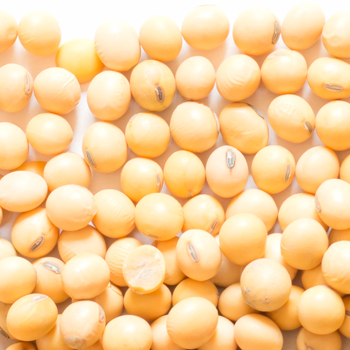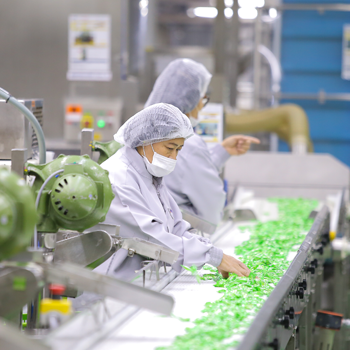โครงการต้นแบบผลิตภัณฑ์เกลือลดโซเดียม: การใช้ประโยชน์และการถ่ายทอดเทคโนโลยีเชิงพาณิชย์
โดย: ชุษณา เมฆโหรา
Chusana Mekhora
Researcher Professional Level
Department of Nutrition and Health
Institute of Food Research and Product Development (IFRPD)
Kasetsart University
ifrcnm@ku.ac.th
การบริโภคอาหารที่มีโซเดียมสูงเป็นสาเหตุของการเกิดโรคไม่ติดต่อเรื้อรังที่เป็นปัญหาสุขภาพของประชากรไทย เช่น ความดันโลหิตสูง โรคหลอดเลือดหัวใจ อัมพฤกษ์อัมพาต และโรคไต รวมถึงส่งเสริมให้เกิดพฤติกรรมติดเค็ม ทำให้การลดปริมาณโซเดียมเป็นไปได้ยาก
องค์การอนามัยโลกได้กำหนดให้บริโภคโซเดียมไม่เกินวันละ 2,000 มิลลิกรัม ซึ่งเท่ากับเกลือประมาณ 1 ช้อนชา หรือน้ำปลาประมาณ 2 ช้อนโต๊ะ แต่จากผลการสำรวจที่ผ่านมาในประเทศต่างๆ ทั่วโลก รวมถึงประเทศไทย พบว่าประชากรส่วนใหญ่บริโภคโซเดียมมากเกินกว่าความต้องการของร่างกายถึง 3-4 เท่าตัวซึ่งถือว่าอยู่ในสถานการณ์อันตราย และถ้าไม่ได้รับการควบคุมอาจทำให้อัตราการเจ็บป่วยจากโรคเรื้อรังที่เกี่ยวข้องกับการบริโภคโซเดียมเพิ่มสูงขึ้นในอนาคต
วิธีการที่นิยมใช้ปรับลดปริมาณโซเดียมในผลิตภัณฑ์อาหาร คือ การใช้สารทดแทนเกลือ หรือโพแทสเซียมคลอไรด์ แต่อย่างไรก็ตาม การใช้โพแทสเซียมคลอไรด์อาจก่อให้เกิดรสเฝื่อนในผลิตภัณฑ์ รวมถึงยังมีข้อควรระวังในการใช้กับผู้ป่วยบางโรค เช่น โรคไต หรือโรคหัวใจ ที่ต้องจำกัดปริมาณโพแทสเซียม ดังนั้นการหาแนวทางในการปรับลดโซเดียมโดยไม่ส่งผลกระทบต่อรสชาติเค็มจึงมีความจำเป็น
ทางทีมผู้วิจัยได้ทำการศึกษากระบวนการการปรับลดขนาดอนุภาคเกลือทะเล (Particle size reduction) และใช้สารเสริมรสชาติ (Flavor induced saltiness) เพื่อใช้เป็นทางเลือกในการลดปริมาณโซเดียมหรือเกลือในผลิตภัณฑ์อาหาร โดยที่ผลิตภัณฑ์ยังคงมีรสชาติเค็มใกล้เคียงเดิม
High-sodium food consumptions cause chronic non-communicable diseases (NCDs) such as high blood pressure, coronary artery disease, paralysis, and kidney disease, which affect health problems for the Thai population. Eating behavior also influences people on a salty taste habit that makes it difficult to reduce sodium intake.
The World Health Organization (WHO) has determined not more than 2,000 milligrams of sodium an acceptable daily intake, which equivalent to about 1 teaspoon of salt or 2 tablespoons of fish sauce. Based on previous surveys in countries around the world, including Thailand, this pertains to the majority of the population consuming 3-4 times more sodium than the body’s needs. Over consumption of sodium is however considered dangerous. If not controlled, the rate of chronic illness related to sodium intake would be highly increased in the future.
A popular way to cut back sodium content in food products is to use salt substitutes or potassium chloride. However, the use of potassium chloride may cause unpleasant taste in the food product. Precautions for kidney disease or heart disease patients are necessary to limit the amount of potassium usage. Therefore, finding a tasteful way to reduce sodium without affecting salty flavor is essential.
The researchers studied the particle size of the sea salt reduction process and flavor induced saltiness as an alternative to reducing sodium or salt in food products, but maintaining a sensitivity to the taste as much salt as original.









